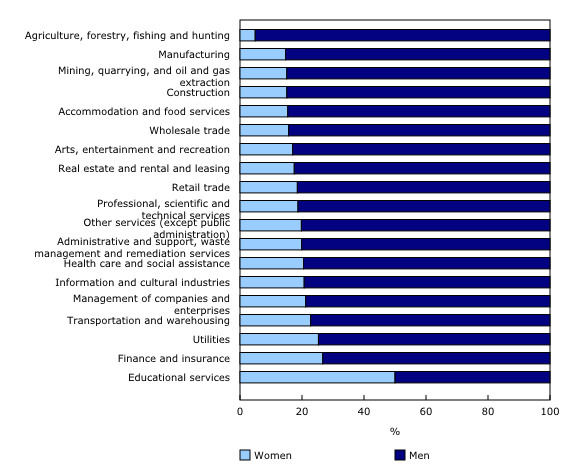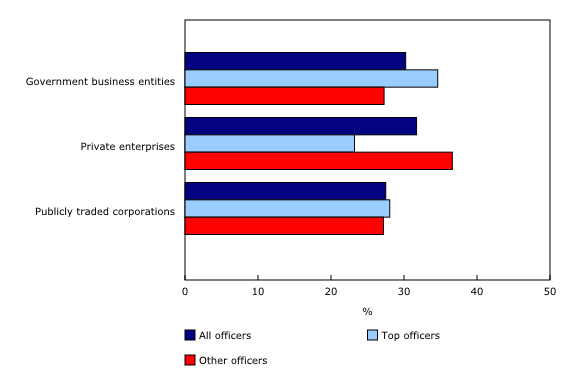Representation of women on boards of directors and in officer positions, 2020
Released: 2023-05-29
Statistics Canada is releasing new data on the gender composition of leadership and strategic decision-making roles within publicly traded corporations, privately held corporations and government business enterprises operating across a variety of industries in Canada.
This release includes data on 2019 and 2020 and offers a snapshot of the representation of women in director and officer positions during the first year of the COVID-19 pandemic. The pandemic had a significant impact on women's employment, with women accounting for more than half of the year-over-year employment losses recorded from March 2020 to February 2021. Despite these setbacks, modest increases in the representation of women in executive positions were recorded from 2019 to 2020.
Additional information and other studies and statistics related to gender and enterprises can be found in the Gender, diversity and inclusion statistics hub, the Business performance and ownership statistics portal and in the Representation of women on boards of directors and in officer positions: Visualization tool.
Women hold just over one in five director positions
In 2020, women occupied just over one-fifth (20.5%) of the 17,996 seats on boards of directors, edging up 0.3 percentage points over the proportion of women recorded in 2019.
The majority of boards of directors did not have any women directors: 59.7% of the 5,810 boards of directors included in the dataset were only composed of men. Over one-quarter (28.0%) of boards of directors had one woman director, while boards of directors with two or more women directors represented 12.3% of the dataset.
Educational services, finance and insurance, and utilities have the highest representation of women directors
Educational services was the only industry in which boards of directors reached gender parity: in 2020, half of its directors were women. However, with 30 board seats, educational services was the industry with both the fewest directors and the fewest women directors.
The finance and insurance industry displayed the second highest share of women directors, with women occupying 26.7% of its board seats.
Corporations classified as utilities had the third highest share (25.3%) of women directors, followed by corporations operating in the transportation and warehousing industry (22.8%).
The agriculture industry had the lowest share of women directors, with 1 in 20 board seats being occupied by women.
Government business entities have the highest share of women on boards of directors
As in previous years, women were most represented on the boards of directors of government business entities in 2020, representing 34.8% of director positions. Publicly traded corporations followed, with a share of 25.2% women directors. Women occupied just under one-fifth of private enterprises' board seats, with a share of 19.8%. Private enterprises tend to drive the overall share of women directors across corporation types, as their board seats made up almost 90% of the dataset on directors in 2020.
A majority of publicly traded corporations had at least one woman director: 85.1% of their boards of directors included at least one woman director, compared with 69.8% of government business enterprise boards of directors and 38.4% of private enterprise boards of directors.
Share of women officers continues to grow at slow pace
In 2020, women made up 31.4% of the 14,807 officers across corporations conducting business in Canada. This represents a gain of 0.8 percentage points over 2019, a modest increase that is nevertheless larger than the one recorded for women directors.
Women are less likely to be represented among top officers
As in previous years, women in leadership positions were less likely to occupy top officer positions. In 2020, women made up a smaller proportion of top officers than of other officers: they held less than one-quarter (23.7%) of top officer positions and over one-third (35.8%) of other officer positions.
Women top officers were most likely to be executive vice-presidents (27.8%) and least likely to contribute in the role of chairperson (1.3%). Among other officers, women made up over half (58.9%) of the 1,437 assistant secretaries. In contrast, one in five (20.3%) treasurers were women.
Information and cultural industries display one of the highest proportions of women officers
With 45.6% women officers in 2020, the "Other services (except public administration)" industry almost reached gender parity. The second highest proportion of women officers (41.2%) was observed among the information and cultural industries. That proportion was over three times the one observed in the agriculture industry (12.0%), in which women officers were the least represented.
Almost one in three of private enterprises' officers are women
Though private enterprises tend to have the lowest share of women directors among all corporation types, in 2020, their share of women officers (31.7%) surpassed the proportion recorded for both government business enterprises (30.2%) and publicly traded corporations (27.5%).
The strong representation of women officers in private enterprises was driven by the "other officers" category: more than one-third (36.6%) of private enterprises' other officers were women, compared with 23.2% of private enterprises' top officers.
Note to readers
Data sources and methodology
The Corporations Returns Act (CRA) program collects financial and ownership data on corporations conducting business in Canada for public, private and government businesses. Corporations are included in the sample if their gross revenues for a fiscal period exceed $200 million, their assets exceed $600 million or their long-term debt or equity owing to non-residents exceeds a book value of $1 million.
However, while these data are used to understand the domestic and foreign residence of corporate board members and officers, they cannot provide information on the gender profile of these individuals.
To identify the gender of these corporate board members and officers, a two-step process was undertaken.
First, the data were integrated, where possible, with gender data from the Derived Record Depository—a national dynamic relational database containing only the basic personal identifiers of Canadians and built by integrating information from administrative data files available at Statistics Canada, including the T1 Personal Master file, for the purpose of facilitating the integration of data from other files.
Then, for the records that could not be integrated, probabilistic imputation was employed using information available about the corporate board members and officers.
The data obtained through the CRA program are used to evaluate the extent of foreign control in the Canadian economy and are summarized in an annual report to Parliament. To release information from the CRA program, Statistics Canada must receive approval from Parliament.
Definitions
Board of directors: The governing body of a corporation.
Executives: Individuals who occupy a leadership and strategic decision-making role within an enterprise and who contribute as either a board director or an officer.
Directors: Individuals responsible for supervising the activities of a corporation and for making decisions for those corporations.
Officers: Individuals responsible for leading the day-to-day operations of a corporation.
Table
The data table used for this analysis is available today (Table 33-10-0501-01 – Representation of women and men on boards of directors, by gender and by firm's attribute).
Visualization tool
The Representation of women on boards of directors and in officer positions: Visualization tool is a comprehensive analytical tool that presents annual changes to the representation of women and men on boards of directors in Canada.
Revision policy
Statistical revisions are carried out annually to incorporate the most current information available. Generally, these revisions are limited to the previous reference year.
Periodically, comprehensive revisions could be conducted, which would generally entail revisions beyond the scope of the standard revision window. These provide an opportunity to enhance estimation methods and incorporate improved data sources and concepts.
Sources of revisions
The revisions to data for reference year 2019 came primarily from an update of the 2019 dataset and from methodological enhancements. These revisions are described below. As a result of these revisions, new benchmark information is available with the use of additional sources, notably, the use of tax data information to ensure that most of the units met the inclusion criteria of the Corporations Returns Act. Furthermore, the units that were inactive within the reference year based on the administrative data files and that reported tax revenues lower than $30,000 were removed. Units operating in the Holding companies (North American Industry Classification System [NAICS] 551113) and Head offices (NAICS 551114) industries were included even if their reported revenues were below $30,000.
Impact of the revisions
Data on the gender of board directors for reference year 2019 were revised from 22,605 directors to 17,890, while the number of officers was revised from 19,044 to 15,017. The proportion of women board directors for the reference year 2019 was revised up to 20.5% from 19.2%, while that of officers was revised down from 30.7% to 30.6%.
Requirement to disclose
Under the Canada Business Corporations Act, publicly traded corporations are required to disclose information on the number of women on their boards, and their diversity policies, targets and statistics in relation to the four employment equity groups for boards of directors and executive officer positions. Essentially, while it will not be mandatory for public corporations to adopt diversity policies or quotas, they will also be required to disclose whether they did so or not and—if not—to explain why.
Products
The Representation of women on boards of directors and in officer positions: Visualization tool, which is part of the series Statistics Canada - Data Visualization Products (71-607-X), is now available.
Contact information
For more information, or to enquire about the concepts, methods or data quality of this release, contact us (toll-free 1-800-263-1136; 514-283-8300; infostats@statcan.gc.ca) or Media Relations (statcan.mediahotline-ligneinfomedias.statcan@statcan.gc.ca).
- Date modified:



